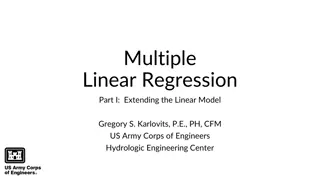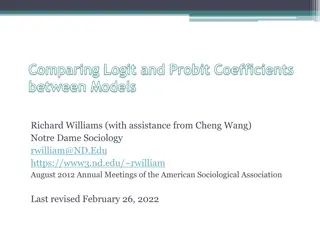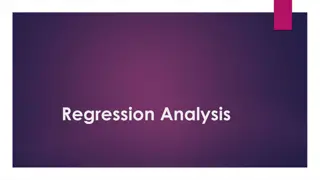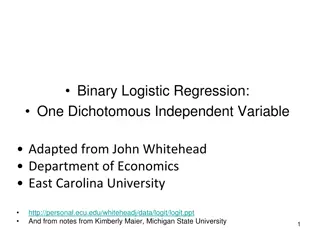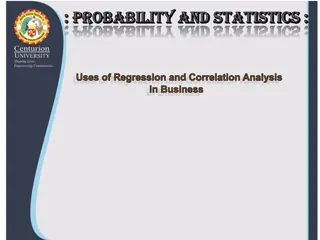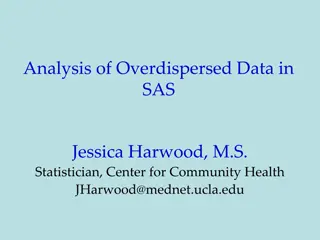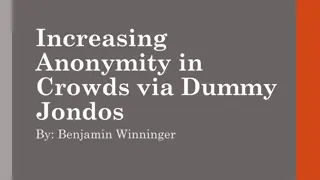Understanding Dummy Variables in Regression Analysis
Dummy variables are essential in regression analysis to quantify qualitative variables that influence the dependent variable. They represent attributes like gender, education level, or region with binary values (0 or 1). Econometricians use dummy variables as proxies for unmeasurable factors. These variables help capture variations in qualitative factors and allow for quantitative analysis in regression models.
Download Presentation

Please find below an Image/Link to download the presentation.
The content on the website is provided AS IS for your information and personal use only. It may not be sold, licensed, or shared on other websites without obtaining consent from the author. Download presentation by click this link. If you encounter any issues during the download, it is possible that the publisher has removed the file from their server.
E N D
Presentation Transcript
Dr. Jyolsna. S Assistant Professor Department of Econometrics NSS College Pandalam
DUMMY VARIABLES REGRESSION MODELS DUMMY VARIABLES REGRESSION MODELS
DUMMY VARIABLES DUMMY VARIABLES
Sometimes the dependent variable of the regression model may be influenced not only by the variables that can be readily quantified on a well-defined scale, but also by variables that are qualitative in nature.
example, salary of college teachers may depend on their degree qualifications. College teachers with PhD may earn more than their non-PhD counterparts. In this example, the explanatory variable represents an attribute or quality, which is PhD or non- PhD. To quantify such an attribute or quality we use an artificial variable that is assigned 1 or 0 values; 1 indicating presence of the attribute (PhD) and 0 indicating its absence.
The variables that assume such 1 or 0 values are called dummy variables. Alternatively, the dummy variables are called qualitative variables, binary variables, dichotomous variables etc. Clearly, dummy variables are needed to quantitatively express the qualitative non- numerical variables.
A dummy variable is a variable which we construct to describe the development of variation of the variable under consideration. We assign to it arbitrary units in such a way as to approximate as best we can the variations in the factor which we want to express quantitatively.
Dummy variables are constructed by econometricians to be mainly used as proxies for other variables which cannot be measured in any particular case for various reasons.
Dummy variables are commonly used as proxies for qualitative factors such as profession, religion, sex, region etc. example suppose we have a sample of family budgets from all regions of the country, rural and urban, and we want to estimate the demand for tobacco manufacturers as a function of income. It is known that town dwellers are heavier smokers than farmers. Thus region is an important explanatory factor in this case. represent this factor by a dummy variable to which we might assign arbitrarily the value 1 for a town dweller and zero for a person living in rural area.
The demand function is Di = b0+ b1X1i+ b2X2i+ ui; where X1= income and X2= dummy variable for region (b2>0)
Dummy variables may be used as proxies for quantitative factors, when no observations on these factors are available or when it is convenient to do so. For example suppose we want to measure the savings function [S= f(Y)] from a cross section sample of consumers. Obviously age is an important explanatory factor of the consumption and savings pattern of a community, since people become thriftier with age. Although age is a quantitative factor, we may approximate it by a dummy variable.
We may divide the consumers in three age groups, each group containing persons with more or less similar consumption and saving patterns. Group A = people of 20-35 years of age Group B = people of 35 and over. On the assumption that people become more thrifty as they grow old, the dummy variable for age may be defined the value zero, if the person belongs to the first age group and the value 1 if the person belongs to the second group.
The savings function assumes the form Si= b0+ b1Yi+ b2Zi+ ui; where Yi = income and Zi= dummy variable for age , (b2 > 0)
Suppose that we have a data on the consumption for the period 1900-1968. During this period we had two world wars (1914-1918) and (1940-45) and a deep depression (1929-1933). The abnormal conditions prevailing in these years have caused a shift of the consumption function downwards, due to rationing, various controls and other factors. To capture this shift we may use a dummy variable, Z, which would assume the value 0 during the above abnormal years and 1 in the other years.
The consumption function assumes the form Ct= b0+ b1Y + b2Z + u; b2> 0 Where Y = income Z = dummy variable for the shift in the function
It is known that over long periods of time, or in abnormal (war) years not only do the functions shift (their constant intercept changes) but also their slopes may well be expected to change; elasticities and propensities change over time. The change in the parameters of a function may be captured by introducing appropriate dummy variable in the function.
The dependent variable of a function may be a dummy variable. For example suppose that we want to measure the determinants of car-ownership from a cross-section sample. Some people will have cars while others will not. Assume that the determinants of the ownership function are income and profession; C= b0+ b1Y + b2A + u Where C= car owners or non-owners Y = income A = a dummy variable for profession Obviously the dependent variable, C, will be a dummy variable which may be designed the value 1 for a person who owns a car, and zero for a person who does not. In this case we say that the dependent variable is dichotomous.
One of the most common applications of dummy variables is in removing seasonal variations in time series. For example we have quarterly data on retail sales, we should adjust for bulk purchase at Christmas and Easter before attempting to measure the influence of other factors in demand. The seasonal adjustment in this case can be estimated by including among the explanatory variables three dummy variables, Q1, Q2 and Q3.
The quarterly regression model is Y Yt t= b + a = b0 + a2 2Q Q2t 0 + b 2t+ a + b1 1X X1t + a3 3Q Q3t 1t + + --------------- 3t+ +u ut t ---------------+ + b bk kX Xkt kt+ a + a1 1Q Q1t 1t Where Q1t = 1 in the first quarter; and 0 in all other quarters Q2t= 1 in the first quarter; and 0 in all other quarters Q3t= 1 in the first quarter; and 0 in all other quarters



